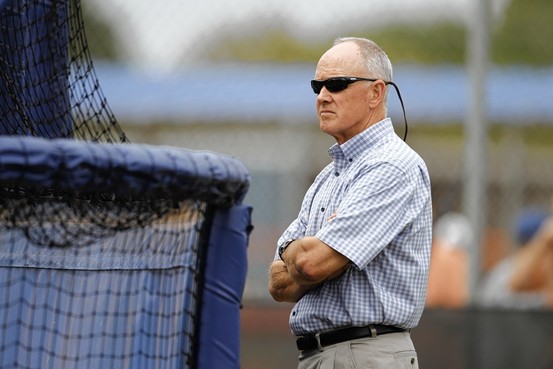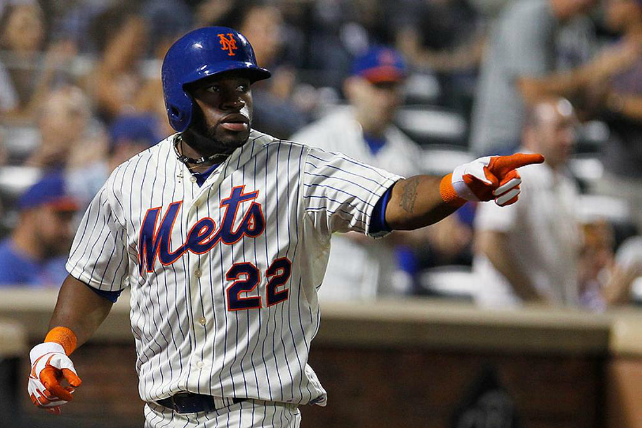 As the trade deadline nears, the debate grows more intense every day as to the approach the Mets should take with respect to their more marketable players. Should they approach next year with an expectation to contend and hold on to all key components of what appears to be a newly energized roster? Or should they be taking a hard look at the big picture for holes yet to be filled that may best be addressed by the trade market? It is an interesting conundrum that they find themselves in: showing real improvement in the past few weeks and playing some of their best ball of the season, but leaning heavily on outlier factors like a career season from a 35-year old journeyman (Marlon Byrd), a string of fine starts by a seeming scrap-heap pickup (Jeremy Hefner), and surprising production from a motley crew of mid-career role players (Josh Satin, Omar Quintanilla, Andrew Brown). Is this team whole greater than the sum of its parts? Possibly. If so, what represents the soundest course of action going forward?
As the trade deadline nears, the debate grows more intense every day as to the approach the Mets should take with respect to their more marketable players. Should they approach next year with an expectation to contend and hold on to all key components of what appears to be a newly energized roster? Or should they be taking a hard look at the big picture for holes yet to be filled that may best be addressed by the trade market? It is an interesting conundrum that they find themselves in: showing real improvement in the past few weeks and playing some of their best ball of the season, but leaning heavily on outlier factors like a career season from a 35-year old journeyman (Marlon Byrd), a string of fine starts by a seeming scrap-heap pickup (Jeremy Hefner), and surprising production from a motley crew of mid-career role players (Josh Satin, Omar Quintanilla, Andrew Brown). Is this team whole greater than the sum of its parts? Possibly. If so, what represents the soundest course of action going forward?
Baseball is filled with examples of players who developed into regulars or at least steady, contributing major leaguers once they found the right opportunity at the right point of their development. I believe that this could certainly be the case with players such as Hefner and Satin. Hefner seems cut from the same cloth as former Met Rick Reed, whose career staggered along for years as he bounced between the minors and the bigs for various organizations before he found the right situation at age 32 in New York and subsequently reeled off 6 creditable seasons as a rotation regular for the Mets and Twins. Hefner may have found his niche at an earlier age (27) but displays a similar mix of the kind of pitches and guile that made Reed successful during his career peak. Satin may not have a position per se, but in a short time has impressed many with his strike zone judgment and ability to put the fat part of the bat on the ball.
Players such as Satin and Hefner represent one type of organizational development for the Mets: the ability to produce and/or collect useful players who, while probably lacking star-level abilities, still contribute enough to help push the team closer to contention. The surprisingly effective Carlos Torres fits in this category as well and has been a highlight of the suddenly stingy bullpen.
Gratifying performances from role players aside, the team as presently comprised still poses plenty of questions going forward, particularly for next season. Catcher is certainly a position slated for change, as hopes remain for Travis D’Arnaud’s recovery and eventual ascension to the role presently held by John Buck. If the apparently brittle D’Arnaud can stay healthy and give a reasonable showing in September, he will be anointed as the new starter behind the dish. Given his lack of experience and checkered track record of durability, is it not reasonable to expect a period of adjustment for both him and the Mets’ mound staff before they get into the kind of groove that typically coincides with a winning record? Will the infield remain in a state of flux as answers are sought at short and first? What shape will the outfield take if management seizes the opportunity to deal Marlon Byrd for a useful future component? Now that the Tigers have apparently found a closer they can live with in the person of Joaquin Benoit, will the Red Sox come calling after Bobby Parnell and will the Mets listen?
 Because the Mets’ pitching staff has started to flash the potential so many have looked for and the offense has picked up since the arrival of Eric Young Jr., hopes and expectations are high both for the near-term and the long run. Odds are that the second half will prove more successful than the first, but ultimately, the team that takes the field for the 2014 campaign should still have some significant differences from the current edition. Byrd’s production has been just the ticket for an offense that cries out for someone to provide support for David Wright, but would it be wise for the organization to commit further to a player of his age having what has become an atypically big power surge? Granted, there have been recent examples of older players putting together a string of good seasons (see Raul Ibanez circa 2006-the present), but as Byrd’s season seems to be an anomaly based on his track record, would the Mets be wise to bet on repeat performances at ages 36, 37, and beyond? This is the type of gamble more usually taken by clubs with deep lineups in need of a complimentary player to help put them over the top. Despite the recent uptick in run production, the Mets wouldn’t seem to qualify as one of those teams quite yet.
Because the Mets’ pitching staff has started to flash the potential so many have looked for and the offense has picked up since the arrival of Eric Young Jr., hopes and expectations are high both for the near-term and the long run. Odds are that the second half will prove more successful than the first, but ultimately, the team that takes the field for the 2014 campaign should still have some significant differences from the current edition. Byrd’s production has been just the ticket for an offense that cries out for someone to provide support for David Wright, but would it be wise for the organization to commit further to a player of his age having what has become an atypically big power surge? Granted, there have been recent examples of older players putting together a string of good seasons (see Raul Ibanez circa 2006-the present), but as Byrd’s season seems to be an anomaly based on his track record, would the Mets be wise to bet on repeat performances at ages 36, 37, and beyond? This is the type of gamble more usually taken by clubs with deep lineups in need of a complimentary player to help put them over the top. Despite the recent uptick in run production, the Mets wouldn’t seem to qualify as one of those teams quite yet.
It is this state of “betwixt and between” that so many fans find frustrating. The team appears to be on the right path and looks to be nearing a period of where they will be able to consistently vie for a playoff position, yet still has so little certainty with respect to a number of crucial positions. Second half performances on the part of some key players such as Ike Davis may help resolve some of the the questions going forward, but some choices will need to be made soon that will clearly influence the look of the 2014 roster.
Having spawned what is now referred to as the “Zack Wheeler effect,” Sandy Alderson has shown that he is loath to surrender a desirable commodity for less than what he considers a major piece for the future. With that future getting ever closer, how should fan expectations be tempered for next season if a similar trade opportunity presents itself this year? One really couldn’t accuse the Mets of punting 2014 if a trade for Byrd or Buck were made but if a someone closer to what might be considered a “foundation” player were moved, say Parnell, would fans accept it as the right thing to do?
For the team to contend consistently in the years ahead, they must replicate on a larger scale what they have done in microcosm these past few weeks-combine effective pitching with a consistent offense. Much of the malaise that affected the team in the downdraft that comprised most of this season’s earlier going can be linked directly to paltry run production. Yes, the bullpen certainly contributed its fair share of nonperformance, but no one is going to win regularly scoring 3 runs or less per game. The Mets have a pitching foundation in place, and in another year it will be stronger. But a steadier level of run production is not implied based on the pieces presently within the system. If the chance to obtain a needed long term boost for the lineup comes along, they will need to take it.
Although many might be tempted to view the team’s recent spate of success as a harbinger of an immediate pennant pursuit, a more reasoned approach will keep things in perspective and be willing to take a step back, if necessary, to take two steps forward. Slow and steady might not be a popular approach to contention in the New York market, but it may be best to maintain it at this point with the transition to a balanced, perennial contender so close.














